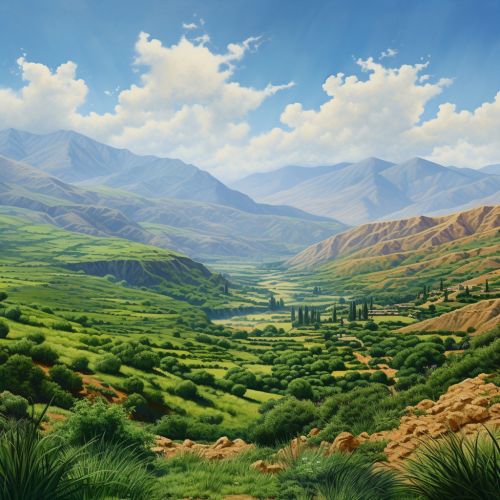Tell Atlas
Geography
The Tell Atlas is a mountain range in North Africa, extending from Morocco through Algeria to Tunisia. It forms part of the Atlas Mountain System, which also includes the Saharan Atlas and the Aurès Mountains. The Tell Atlas is characterized by its Mediterranean climate, with wet winters and hot, dry summers.


The range stretches approximately 1,500 kilometers (930 miles) from the Moroccan Atlantic coast to the Tunisian border. The width of the range varies between 60 and 190 kilometers (37 and 118 miles). The highest peak in the Tell Atlas is Mount Tahat, which reaches an elevation of 2,908 meters (9,541 feet).
Geology
The Tell Atlas is primarily composed of folded and thrusted sedimentary rocks from the Mesozoic and Cenozoic eras. These rocks were formed from sediments deposited in a shallow sea that covered the region during these periods. The folding and thrusting of these rocks occurred during the Alpine orogeny, a mountain-building event that took place in the late Cenozoic era. This event also resulted in the formation of the Alpine and Himalayan mountain ranges.
The geology of the Tell Atlas is complex and varied, with numerous faults and folds. These structural features have been the focus of numerous geological studies, as they provide valuable insights into the tectonic history of the region. The range is also rich in mineral resources, including iron, lead, zinc, and phosphates.
Climate and Vegetation
The climate of the Tell Atlas is Mediterranean, characterized by wet, mild winters and hot, dry summers. The range acts as a barrier to the dry, hot winds from the Sahara, resulting in a relatively humid and temperate climate on the northern slopes. This climate supports a diverse range of vegetation, including forests of cork oak, holm oak, and Aleppo pine.
The southern slopes of the range, which face the Sahara, have a drier climate and support a different type of vegetation, dominated by xerophytic (drought-tolerant) species such as juniper and prickly pear.
Fauna
The Tell Atlas is home to a diverse range of animal species, many of which are endemic to the region. These include the Barbary macaque, the Atlas deer, and the Algerian nuthatch. The range is also an important habitat for a number of bird species, including the Bonelli's eagle, the Barbary partridge, and the Algerian warbler.
Human Settlement and Activities
The Tell Atlas has been inhabited by humans for thousands of years. The region has a rich cultural history, with numerous archaeological sites dating back to the Roman and Berber periods. Today, the range is home to a diverse mix of peoples, including Berbers, Arabs, and French settlers.
Agriculture is the main economic activity in the region, with the fertile valleys and plains of the Tell Atlas supporting a variety of crops, including cereals, olives, and grapes. The region is also known for its wine production, with a number of vineyards located on the northern slopes of the range.
Conservation Issues
Despite its rich biodiversity, the Tell Atlas faces a number of conservation issues. These include deforestation, overgrazing, and soil erosion. The region is also threatened by climate change, which is expected to result in increased temperatures and decreased rainfall in the coming decades.
Efforts are being made to conserve the unique ecosystems of the Tell Atlas, including the establishment of national parks and nature reserves. However, these efforts face numerous challenges, including limited funding and conflicts between conservation goals and local economic activities.
